Tag Archive: modeling
April 14, 2019
by Carole Zangari -
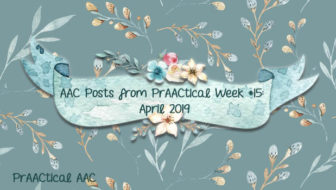
Good morning, AAC friends. Here are the posts we published this week. Monday – AACtivity of the Month: Concept Sorts Tuesday – AAC Link Up Wednesday – Video of the Week: Strategies for Supporting AAC Team Buy-In & Implementation Thursday – How I do it: Using Videos & Instructional Feedback to Support Communication Partners ::::::::::::::::::::::::::::::::::::::::::::::::::::::::::::::::::::::::::::::::::::::::::::::::::::::::::::::::::::::::::::::: Have time for a little more browsing? Check out these past posts. When Helping Isn’t Helping-Prompt Awareness in AAC Instruction Administratively Speaking: 5 Considerations for Recruiting and Retaining AAC SLPs AAC In the Classroom: Considerations for Modeling Core Vocabulary How I Do It: A Year of Core Word in Action AAC in the High School Classroom: Where Core Vocabulary Meets Life Skills
Filed under: Featured Posts, PrAACtical Thinking
Tagged With: classroom, modeling, prompting, summary week
February 20, 2019
by Carole Zangari -

How can we use modeling to help AAC learners move toward linguistic competence? In today’s featured video, Dr. Melissa Malani has lots of ideas for how to do this in the context of shared book reading. Many thanks to Melissa and the wonderful team at Saltillo for creating this presentation and making it widely available. Direct Link to Video – https://www.youtube.com/watch?v=ehvAwtDX-lM
Filed under: Video of the Week
Tagged With: aided language input, modeling, shared reading
May 31, 2018
by Carole Zangari -
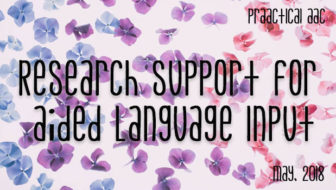
Aided language input, the practice of modeling AAC when speaking to those who are trying to learn AAC, is a pivotal intervention strategy. It has been shown to support comprehension and expression, and the development of early sentence forms. The evidence suggests it may also support the development of certain grammatical morphemes and verb combinations. You can learn more about the implementation of aided language input here. Here are some of the research studies that support the use of this evidence-based practice. Binger, C., & Light, J. (2007). The effect of aided AAC modeling on the expression of multi-symbol messages by preschoolers who use AAC. Augmentative and Alternative Communication, 23, 30–43. Binger, C., Maguire-Marshall, M., & Kent-Walsh, J. (2011). Using aided AAC models, recasts and contrastive targets to teach grammatical morphemes to children who use AAC. Journal of Speech, Language and Hearing Research, 54, 160–176. Dada, S., & Alant, E. (2009). The... [Read More...]
Filed under: Featured Posts, PrAACtical Thinking
Tagged With: aided language input, EBP, modeling, research
April 11, 2018
by Carole Zangari -

Speak AAC to Teach AAC It’s wonderful to see how many people are actively working on their own skills in aided language input. Today’s video, from the Communication Technology Education Center (CTEC) in northern California, addresses a question that many communication partners have: How much language should I model? Kudos to the STAR team at CTEC for this engaging video. Enjoy! Direct Link to Video – https://www.youtube.com/watch?v=VppaSuAF0f4
Filed under: Video of the Week
Tagged With: aided language input, modeling
June 7, 2017
by Carole Zangari -
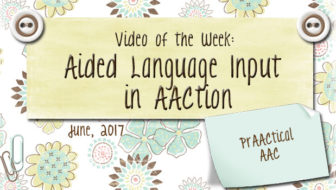
Do you know students like these? In therapy sessions, Victor uses single words on his SGD to participate in games and activities, but doesn’t use it much during other daily experiences. Bella uses PECS quite capably at mealtimes but rarely uses it at other times during the day. Karina can use her AAC app to put together short narratives to tell about things that happened recently. Most times, though, she expresses herself with single word utterances. As therapists, teachers, and families who support people who use AAC, we do a lot of hand wringing when there is a discrepancy between what students KNOW HOW to do and what they DO do. We are perplexed and frustrated when these students have everything they need to utilize a particular skill, yet fail to do so. It’s a common concern, but here’s a question for us to ask ourselves: Don’t we do the... [Read More...]
Filed under: Video of the Week
Tagged With: aided language input, modeling, reading, video
May 31, 2017
by Carole Zangari -
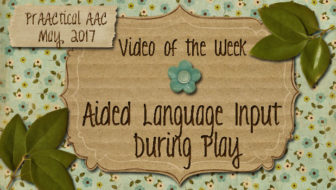
Typically developing children acquire language not through direct instruction but by immersion in an environment where the language of the community is modeled all day long. When they eat and when they play, in care routines at home and in exchanges in the community, children are continually hearing the language they are learning to produce. When parents of Deaf or hard of hearing babies learn of their children’s disability, many clamor to learn sign language and use it as they bathe, feed, and play with their children. These parents may not be perfect sign language models, but they understand that their efforts to learn and use sign language will play a critical role in helping their children learn to communicate effectively. Thus, they strive to sign all day long as they talk to their kids. The pervasive, contextually-driven exposure to language is the foundation on which children build skills in... [Read More...]
Filed under: Video of the Week
Tagged With: aided language input, language development, modeling, play
January 26, 2015
by Carole Zangari -

One of the coolest things about 2014 was that it seemed like the field of AAC reached a tipping point regarding the idea of aided language input. There are some differences in terminology (e.g., aided language stimulation, aided modeling), but the Big Idea is this: To teach AAC, be a speaker of AAC. Learners need competent language models, and if we’re not using the AAC ourselves, chances are that no one else is easier. If you don’t think that’s a problem, try learning a foreign language from a teacher who doesn’t speak it to you. Not the most enjoyable, effective, or efficient way to learn. I had such a great visit to schools in Oakland, Michigan this fall, and one of the (many) highlights was being in classrooms where teachers and SLPs are taking this to heart. True, they have some great AT leadership and had lots of training, but... [Read More...]
Filed under: PrAACtical Thinking
Tagged With: aided language input, modeling, Oakland Schools
June 28, 2013
by Carole Zangari -
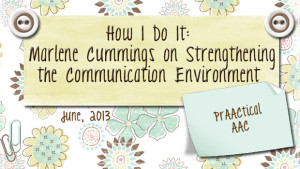
Marlene Cummings is back to share some thoughts on creating communication-friendly environments. As an AAC consultant to the Oakland Schools, Marlene gets to support AAC implementation in a variety of classrooms with all types of learners. You can read her earlier posts here and here. ::::::::::::::::::::::::::::::::::::::::::::::::::::::::::::::::::::::::::::::::::::::::::::::::::::::::::::::::::::::::::::::::::::::::::::::::::::::::: 5 Things to Consider in the “Communication Environment” The first thing we want to ask: Is language being represented visibly? We in AAC are often known by our “stuff”. Because we need to represent language visibly and love technology, we typically have a lot of “stuff”. I, for one, currently have a large storage unit holding 30+ years of “stuff” waiting to be distributed to all my new teams since I am no longer in the classroom. Let’s start by looking around our instructional environment. It is our intention to model the use of language being represented visibly and to provide the vocabulary and opportunities for... [Read More...]
Filed under: PrAACtical Thinking
Tagged With: 24/7, access, aided languagge input, classroom, core vocabulary, education, Marlene Cummings, modeling, opportunity
May 19, 2013
by Robin Parker -
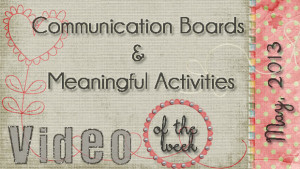
Gail Van Tatenhove expertly demonstrates teaching with a Pixon communication board. In this video, she introduces the communication board and implements a variety of best practice AAC teaching strategies. Can you spot them?
Filed under: Video of the Week
Tagged With: communication boards, Gail Van Tatenhove, modeling








